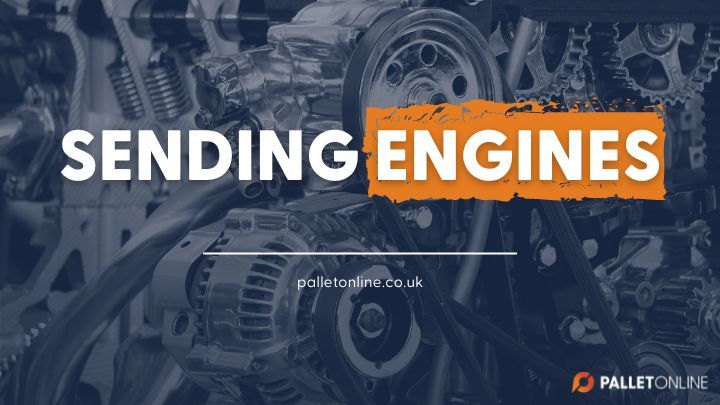What You Need To Know About Shipping An Engine
When shipping car parts, it is crucial to ensure the safety of both your items and the car parts courier.

You should know that engines must be packed and secured in a particular way for them to be accepted by your chosen pallet courier.
If you are new to shipping an engine and need some expert advice to help set you on the right track, we are here to help you.
Following our top tips and advice will help ensure your engine is accepted, avoid putting people at risk, and will also minimise the risk of your engine arriving damaged.
All Fluids Must be Drained
Firstly, for your engine to be shipped safely, it must be drained of all fluids. This includes any residual oil and water, so it is always worth thoroughly inspecting it before the packing and wrapping process begins.
Supposing this is your first time shipping an engine or you're new to engines altogether, you can always ask a professional to see if there are any residual fluids.
If there are any residual fluids, they may be able to help drain them or advise you on how to do this yourself, safely.

The engine courier will check the engines' oil levels when they arrive to collect, and if there is oil present they will refuse to ship the engine.
The engine must meet all shipping requirements to be accepted by the courier. Failing to adhere to these will result in delays and potential re-collection charges.
Positioning the Engine
Make sure to place the engine right in the middle of the pallet and leave at least three inches of space around it on all sides.
This extra room is super important because if the engine shifts during transportation, having that space will protect it from getting damaged.
If the engine hangs over the edges of the pallet, you might end up with extra charges for using a 2nd, 3rd, or even a 4th pallet space.
So, don't forget to ask about the right pallet size for your engine to keep it safe and avoid any unexpected charges. It's always better to be safe than sorry!
Use An Oil-Resistant Material
For peace of mind and the safety of the pallet courier, we always recommend using an oil-resistant material just in case there are any residual fluids.
You should place this between the pallet and the engine itself. This will help prevent spills and leaks during transit, protecting other consignments and the driver too, for that matter.
If you don't have an oil-resistant material, absorbent materials are the best substitute. These will immediately absorb any residual fluids and prevent them from leaking onto the floor of the trailer, or even other pallets.
Secure with Ratchet Straps
While it is not normally compulsory with normal pallet deliveries, using ratchet straps for added protection is strongly recommended when shipping an engine.

With ratchet straps tightly holding your engine in place, there is much less risk of anything sliding off and causing damage to other pallets in transit.
You should also avoid using rope for your engine pallet delivery. This can wear and break with very little force, causing the engine to slide around during its journey.
Ensure The Driver Can Access The Dipstick
On collection, the driver must be able to access the engine’s dipstick easily to inspect the oil levels.
If the driver cannot access this, your engine may be refused and you may be asked to re-pack your pallet to meet the requirements.
With this in mind, it is crucial to leave a hole when you are shrink-wrapping your engine to the pallet. To do this properly the first time, mark the dipstick up (where it is on the engine) before applying the shrink material. Then you can carefully wrap around, leaving a sufficient amount of room around the area.
This will allow the driver access to the dipstick so that they can inspect the oil levels. Plus, nearly all pallet couriers work on a strict schedule so helping them out this way can also speed the collection up for them and you.
Top Tips
When it comes to shipping your engine with a pallet courier, there are a couple of key things to keep in mind, and we're here to help!
First off, your engine will likely be loaded and unloaded a few times during its journey through the pallet network. That's just how pallet networks work. So, it's vital to play by the rules. Not only will this help you avoid extra charges, but it'll also ensure that your engine arrives at its destination in one piece.
Some folks often place their engine inside a rubber car tyre before securely fastening it to the pallet. By doing this, you can attach ratchet straps to the engine, and the tire will act like a shock absorber, keeping your engine stable during the trip.
But make sure to check with your pallet courier first. You wouldn't want the tyre to stick out from the pallet and risk your engine being rejected by their network.
Of course, if your engine is well-protected and wrapped up nicely, it might not even need that extra support. But, just to be safe, it's always a smart move to get advice from your pallet courier before you load up your engine.
Remember, every courier has their own way of doing things, so they might have different suggestions on how to keep your engine safe and sound during its pallet journey.
For a speedy and super reliable engine delivery service. Look no further than PalletOnline. Get a free and instant quote today.